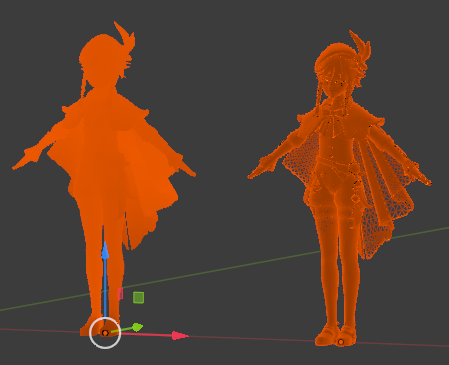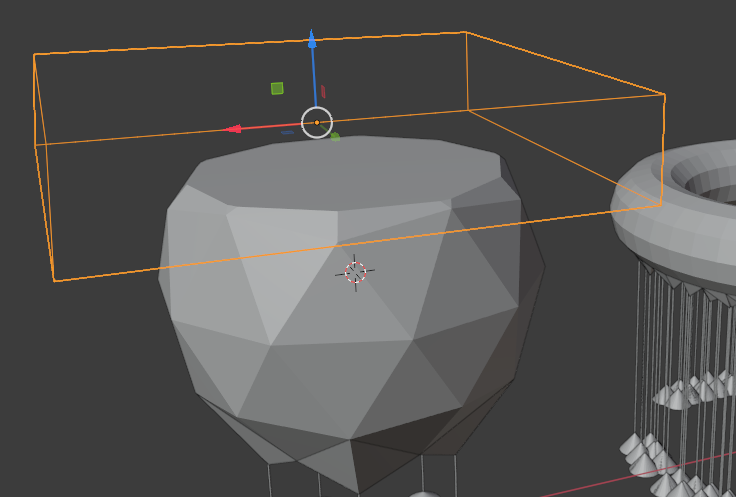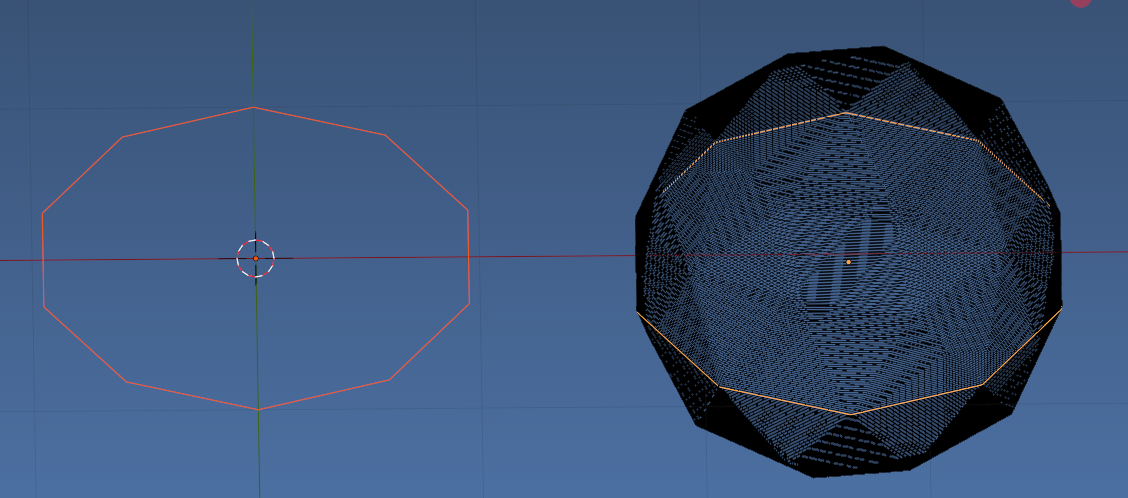Wow I'm seriously impressed (and surprised) I've managed to get Blender to slice my 80k face object into 2000 slices in under 8 seconds (top image - on the R is the original, L is the sliced version).
Unfortunately there seems to be a glitch where sometimes layers are lost or only partially formed - I think it's a bug in the bisect function, not my code - eg bottom photo: the icosphere is missing the middle layer if the slice would be at exactly the midline of the icosphere .
I've included the code below in case its useful to someone.


import bpy, bmesh from bpy import context as C from mathutils import Vector # This code will slice the selected object into a set of vertices and edges # along the direction of the unit vector (normal) # in steps of step_size in local coordinate space #(this ignores the scale property, so make sure to apply it before) # If you want to slice at a different angle then just change the normal, and start # far enough down the z-axis to ensure the plane will slice the entire model # You can calculate step size to give appropriate thickness slices with sqrt(x*x + y*y + z*z) # NB this strategy won't work if you want to cut perpendicular to the z- axis # in that case you'll need to change the code a bit more def newobj(bm, name): me = bpy.data.meshes.new(name) bm.to_mesh(me) ob = bpy.data.objects.new(name,me) #C.scene.objects.link(ob) bpy.data.collections['Slices'].objects.link(ob) return ob # https://blender.stackexchange.com/questions/32283/what-are-all-values-in-bound-box def bounds(obj, local=False): local_coords = obj.bound_box[:] om = obj.matrix_world if not local: worldify = lambda p: om * Vector(p[:]) coords = [worldify(p).to_tuple() for p in local_coords] else: coords = [p[:] for p in local_coords] rotated = zip(*coords[::-1]) push_axis = [] for (axis, _list) in zip('xyz', rotated): info = lambda: None info.max = max(_list) info.min = min(_list) info.distance = info.max - info.min push_axis.append(info) import collections originals = dict(zip(['x', 'y', 'z'], push_axis)) o_details = collections.namedtuple('object_details', 'x y z') return o_details(**originals) #bb = bounds(obj) #print("bounds(bb) = ((",bb.x.min,",",bb.x.max,"),(",bb.y.min,",",bb.y.max,"),(",bb.z.min,",",bb.z.max,"))") # UID Code def make_key(obj): return hash(obj.name + str(time.time())) def get_id(self): if "id" not in self.keys(): self["id"] = make_key(self) return self["id"] # set the id type to all objects. #bpy.types.Object.id = property(get_id) # could store them in the file as a datastore in the window manager. #wm = bpy.context.window_manager #wm["objects"] = 0 #rna = wm.get("_RNA_UI", {}) #rna["objects"] = {o.name: o.id for o in bpy.data.objects} #wm["objects"] = len(rna["objects"]) #wm["_RNA_UI"] = rna # This code will slice the selected object into a set of vertices and edges # along the direction of the unit vector (normal) # in steps of step_size in local coordinate space #(this ignores the scale property, so make sure to apply it before) # If you want to slice at a different angle then just change the normal, and start # far enough down the z-axis to ensure the plane will slice the entire model # You can calculate step size to give appropriate thickness slices with sqrt(x*x + y*y + z*z) # NB this strategy won't work if you want to cut perpendicular to the z- axis # in that case you'll need to change the code a bit more def slicer(step_size = 0.01, normalOfSlice = (0,0,1)): object_details = bounds(C.object, True) bpy.ops.object.mode_set(mode='OBJECT') # If necessary create a new collection to hold the slices if not "Slices" in bpy.data.collections: bpy.context.scene.collection.children.link(bpy.data.collections.new("Slices")) startLoc = object_details.z.min stopLoc = object_details.z.max steps = int((stopLoc - startLoc)/step_size) + 1 # + 1 because we want the faces on either end print("") print("******************** STARTING NEW RUN ********************") print("Slicing into ", steps, "slices") print("between dimensions of: ", startLoc, ":", stopLoc) lBound = 0 halving = [steps] slices = [] slices.append(bmesh.new()) slices[0].from_mesh(C.object.data) # Add UIDs to the faces of the original object which will be propogated through the model # for these purposes just using the original ID will be fine #faceUID = bm.faces.layers.integer.new('faceUID') #faceUID = bm.faces.layers.integer.get('faceUID') #for face in bm.faces: # face[faceUID] = new_UID() #while (halving[-1] > lBound): while len(halving) > 0: if lBound + 1 < halving[-1]: # At the moment we're just created successively halved copies of the mesh. # And adding them to the list # Even though we are duplicate meshes and running the function twice # it is still faster than operating from an original (uncopied) mesh because the bisect function # 1. doesn't seem to index the geometry in any way (so time is proportional to the mesh size) # Splitting at this stage effectively creates indexed bits of meshes) # 2. There appears to be no way to create an inner and an outer copy # in the same step (eg by passing in two bmesh objects to the bisect function) # Thus the bisect function has to be run once on each copy curSlice = int(lBound+(halving[-1]-lBound)/2) slicePoint = startLoc+curSlice*step_size halving.append(curSlice) print ("Splitting Mesh into 2 halves with bounds: ",lBound, ":", halving[-1], ":", halving[-2], "and SlicePoint=", startLoc+lBound*step_size, "-", slicePoint, "-", startLoc+halving[-2]*step_size ) slices.append(slices[-1].copy()) #This slices the original mesh and discards geometry # on the inner = lower index = negative side of the plane bmesh.ops.bisect_plane( slices[-2], geom=slices[-2].verts[:]+slices[-2].edges[:]+slices[-2].faces[:], plane_co=(0,0,slicePoint-step_size), plane_no=normalOfSlice, clear_inner=True) #This slices the duplicated copy of the mesh and discards geometry # on the outer = higher index = positive side of the plane bmesh.ops.bisect_plane( slices[-1], geom=slices[-1].verts[:]+slices[-1].edges[:]+slices[-1].faces[:], plane_co=(0,0,slicePoint+step_size), plane_no=normalOfSlice, clear_outer=True) #print("len(slices) post splitting: ",len(slices)) else: # we've just halved the slice directly above the lower bound so slice again to extract # the top and bottom vertex loops (ie discarding the inner and outer geometry for both) # then create two objects from the data # Finally step back up to next level clearing out the redundant slice data curSlice = int(lBound+(halving[-1]-lBound)/2) upperSlicePoint = startLoc+(curSlice+1.5)*step_size lowerSlicePoint = startLoc+(curSlice+0.5)*step_size slices.append(slices[-1].copy()) print("Extracting last two layers: lowerSlicePoint = ",lowerSlicePoint, "upperSlicePoint = ",upperSlicePoint) # for vert in slices[-1].verts: # print( 'v %f %f %f' % (vert.co.x, vert.co.y, vert.co.z) ) #This time slice the mesh and discard both inner and outer geometry to just leave the vertex loops bmesh.ops.bisect_plane( slices[-2], geom=slices[-2].verts[:]+slices[-2].edges[:]+slices[-2].faces[:], plane_co=(0,0,upperSlicePoint), plane_no=normalOfSlice, clear_inner=True, clear_outer=True) newobj(slices[-2], "bisect-"+str(upperSlicePoint)) #This time slice the mesh and discard both inner and outer geometry to just leave the vertex loops bmesh.ops.bisect_plane( slices[-1], geom=slices[-1].verts[:]+slices[-1].edges[:]+slices[-1].faces[:], plane_co=(0,0,lowerSlicePoint), plane_no=normalOfSlice, clear_inner=True, clear_outer=True) newobj(slices[-1], "bisect-"+str(lowerSlicePoint)) #print("halving list = ", halving) #print ("extracted:",lBound, halving[-1]) lBound = halving[-1]+1 #print ("update: lb1",lBound, halving[-1]) #print ("del:",halving[-1]) del halving[-1] #print("len(slices) post extraction: ",len(slices)) del slices[-2:] #print("len(slices) post drop end: ",len(slices)) #print("len(halving) post drop end: ",len(slices)) # if len(halving) > 0: # print("checking for halving[-1] > lBound exit criteria:",halving[-1],lBound) # if len(halving) == 0: # print("EXITING: len(halving) == 0") # break print("FINISHED") print("Sliced object into ", steps, "slices of ", step_size, "thickness") slices.clear() #C.object.user_clear() # without this, removal would raise an error. #bpy.data.objects.remove(C.object, True) #slicer(step_size = 0.01, normalOfSlice = (0,0,1)) slicer(1, (0,0,1))




